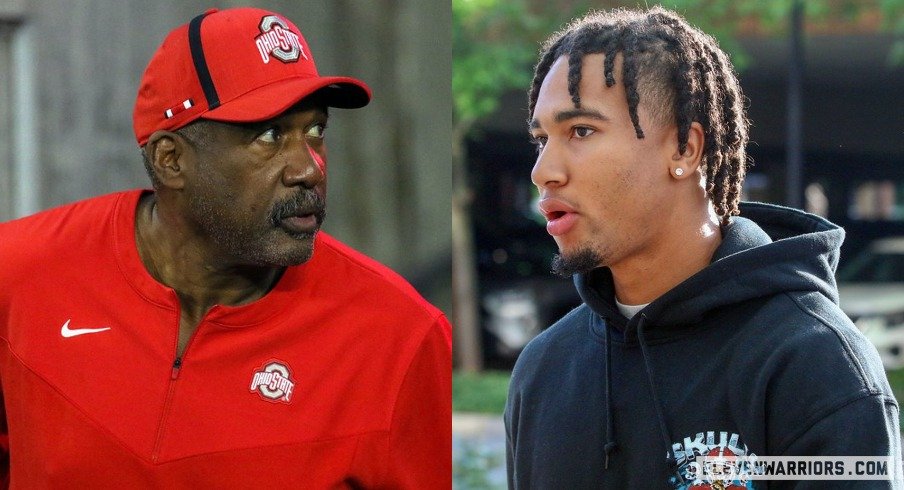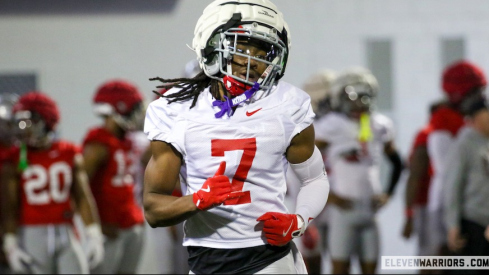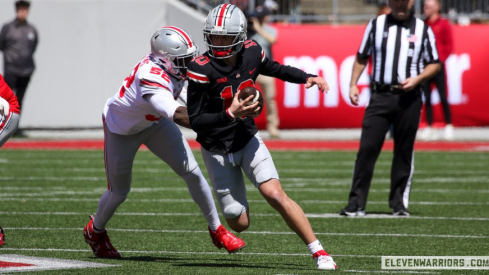Any way you slice it, $8 billion is a jaw-dropping figure.
The Big Ten’s new seven-year TV deal with Fox, CBS and NBC, which begins next year, could reportedly be worth even more than that when the dust settles on the finer financial details. But Ohio State’s starting quarterback and athletic director have different takes on whether or not student-athletes should see a piece of that pie moving forward.
When asked about the subject at a post-practice interview session Thursday, C.J. Stroud admitted “I’ll probably have to think about it a little more,” but ultimately articulated his stance that players and coaches should receive some of that money.
“Just off rip if I would say yes,” Stroud said. “I think coaches as well, like we're not – I feel like this game is definitely amazing, especially in the college atmosphere, because it still does have amateurism to it. I mean they're paying for our school, so I mean, that's definitely a plus. But at the same time, I'm not 100% sure what our tuition is, but I'm sure it's not the worth of how much we're actually worth. So me personally, my mom has always taught me to know my worth.”
Prior to the announcement of the deal, conference commissioner Kevin Warren said at Big Ten Media Days in July that he thinks about the topic “on a daily basis” and wants the conference to “be bold and a leader in that area as we work through what's right for our student-athletes.”
But Gene Smith said Thursday that Big Ten administrators have not broached such a conversation as of yet. Smith said student-athletes already benefit from the revenue generated by Big Ten television rights in the form of the resources they have at their disposal at Ohio State.
“Frankly, they're already getting a piece of the television revenue,” Smith said. “You know, when you aggregate in – you're all familiar with our circle of care and all the people that we put around our student-athletes – and trainers, strength coaches, sports psychologists, nutritionists, academic counselors, just keep going around the list. And that's how we fund those positions. That's how we fund this building. That's how we fund this new field. That's how we fund a new field in the stadium. That's how we fund security that we'll need for 103,000 people in our stadium and maybe 30,000 outside for the tailgating.
“So they actually already get a piece. It might not be directly in their pocket, but it's an investment in them.”
Stroud described the sacrifices made by Ohio State athletes as he stated his case for players to get a cut of the revenue, but also said NIL has enabled them to make money even if they don’t end up directly sharing a portion of the funds from the lucrative TV deal.
“It would definitely mean a lot not only to the players, but to the coaches and the whole – even the school would appreciate just giving us maybe a little something, you know what I mean? Just because, I mean we put in so much work,” Stroud said. “Like we're in here when nobody's looking. All the time that goes into it, it’s definitely tough. Then you take time away from your family, like, I'm 2,000 miles away from home.
“I don't want anybody to feel bad for me, but at the same time it does take a lot of courage and it does take a lot of heart to be here day in and day out, year in and year out. So I definitely think it should be shared, but if not, at the end of the day we have the NIL space and we can do it that way. So the new college world has definitely turned around and I'm here for it.”
Smith didn’t close the door on the possibility for student-athletes to continue earning more money through scholarship opportunities, though. Smith referenced the June 2021 Supreme Court ruling in the NCAA v. Alston case, which now enables institutions to distribute annual awards of up to $5,980 per student-athlete for academic achievement.
Smith said the topic of revenue sharing for players will also be discussed further, but that he won’t entertain the idea of the university directly paying players solely for their on-field services.
“That doesn't mean that the scholarship model might not change,” Smith said. “I mean, this is the first year for us of the Alston distribution where every single student-athlete is getting over $5,900, which is about a $6 million hit to our budget. So they're already getting it. So do we do more down the road? Possibly. And that will be discussed, but not in the form of pay for play. Otherwise I'm out.”


